Introduction
For students preparing for board exams, ICSE Class 10 Physics Selina Solutions for Chapter 4 Exercise 4(C) is an important resource. This section focuses on both theory-based and numerical questions related to Refraction of Light at Plane Surfaces, helping you apply your knowledge to real exam-style problems.
Why Exercise 4(C) is Important
Exercise 4(C) acts as a bridge between the earlier simpler exercises and the more application-based questions in Exercise 4(D). It tests your ability to recall concepts like refractive index, laws of refraction, and apparent depth while also challenging you with problem-solving scenarios.
Benefits of Using Selina Solutions for Exercise 4(C)
- Easy-to-Understand Explanations – Every answer is written step-by-step so you can follow the logic clearly.
- Exam-Oriented Content – The solutions follow the ICSE Class 10 Physics syllabus and marking pattern.
- Balanced Mix of Theory and Numericals – Prepares you for both short-answer and long-answer questions.
Exercise 4(C): (A) Multiple Choice Type
(Choose the correct answer from the options given below).
Question 1
Refractive index of a liquid can be found using :
(a) μ = real depth x apparent depth
(b) μ = apparent depth / real depth
(c) μ = real depth / apparent depth
(d) none of the above
Answer:
(c) μ = real depth / apparent depth
Explanation:
Refractive index is defined as:
μ = real depth / apparent depth
Question 2
A small air bubble in a glass block when seen from above appears to be raised because of:
(a) refraction of light
(b) reflection of light
(c) reflection and refraction of light
(d) none of the above
Answer:
(a) refraction of light
Explanation:
The air bubble is in a rarer medium (air) surrounded by a denser medium (glass). When light passes from glass (denser) to air (rarer), it bends away from the normal. Due to this refraction, the bubble appears raised to the observer.
Question 3
An object in a denser medium when viewed from a rarer medium appears to be raised. The shift is maximum for:
(a) red light
(b) violet light
(c) yellow light
(d) green light
Answer:
(b) violet light
Explanation:
Refractive index is higher for violet light than red light (due to its shorter wavelength). Higher refractive index leads to greater bending of light and thus more apparent shift. So violet light gives the maximum shift.
Question 4
The shift by which an object appears to be raised depends on:
(a) the refractive index of the medium
(b) the thickness of denser medium
(c) the wavelength of incident light
(d) all of the above
Answer:
(d) all of the above
Explanation:
The shift depends on refractive index, depth of the medium, and wavelength since all three affect how much light bends at the interface.
Question 5
An object when placed in a rarer medium and is viewed from a denser medium appears to be at a …………… distance than its real distance.
(a) Smaller
(b) greater
(c) same
(d) cannot say
Answer:
(b) greater
Explanation:
When viewing from denser to rarer medium, the object appears farther than its actual position due to bending of light away from the normal.
Question 6
A glass slab is placed over a piece of paper on which VGYR is printed with letter V in violet, G in green, Y in yellow and R in red colour. The letter of colour …………… appears to be the most raised.
(a) red
(b) green
(c) yellow
(d) violet
Answer:
(d) violet
Explanation:
Each color has a different refractive index. Violet light has the highest refractive index, hence more bending, which results in more shift and makes it appear most raised.
Question 7
Assertion (A): The stars twinkle while the planets do not.
Reason (R): Stars are more distant than the planets.
(a) Both A and R are true and R is the correct explanation of A
(b) Both A and R are true and and R is not the correct explanation of A
(c) assertion is false but reason is true
(d) assertion is true but reason is false
Answer:
(b) Both A and R are true and and R is not the correct explanation of A
Explanation:
Both statements are true, but the twinkling of stars is due to atmospheric refraction, not just their distance. Planets appear larger and their light averages out, so they don’t twinkle.
Question 8
Assertion (A): An empty test tube placed in water in a beaker with its mouth outside the water surface appears silvery when viewed from a suitable direction.
Reason (R): The substance in water appears silvery due to refraction of light.
(a) Both A and R are true and R is the correct explanation of A
(b) Both A and R are true and and R is not the correct explanation of A
(c) assertion is false but reason is true
(d) assertion is true but reason is false
Answer:
(d) assertion is true but reason is false
Explanation:
The test tube appears silvery due to total internal reflection, not refraction — so the assertion is correct, but the reason is incorrect.
Question 9
Assertion (A): A ray of light travelling from a rarer medium to a denser medium, slows down and bends away from the normal.
Reason (R): The speed of light is higher in a rarer medium than in a denser medium.
(a) Both A and R are true and R is the correct explanation of A
(b) Both A and R are true and and R is not the correct explanation of A
(c) assertion is false but reason is true
(d) assertion is true but reason is false
Answer:
(c) assertion is false but reason is true
Explanation:
Light slows down in a denser medium (true), and the reason is also true. But the ray actually bends towards the normal (not away), so the assertion is false but reason is correct.
Exercise 4(C): (B) Short Questions
Question 1
How is the refractive index of a medium related to the real and apparent depths of an object in that medium?
Answer:
The refractive index is given by: \(\mu=\frac{Real\ Depth\ }{Apparent\ Depth}\)
Question 2
An object placed in one medium when seen from the other medium, appears to be vertically shifted. Name two factors on which the magnitude of the shift depends and state how does it depend on them.
Answer:
The shift (or apparent rise) depends on:
(i) The refractive index of the medium: Greater the refractive index, greater the shift.
(ii) The thickness of the denser medium: Thicker the medium, more is the shift.
(ii) The colour or wavelength of incident light: The shift decreases with the increase in the wavelength of light used.
Exercise 4(C): (C) Long Questions
Question 1
Prove that, \(Refractive\ index=\frac{Real\ depth}{Apparent\ depth}\)
Answer:
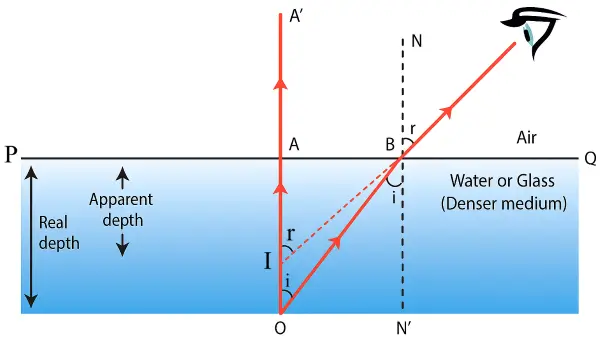
Consider a point object O kept at the bottom of a transparent medium (such as water or glass) separated from air by the surface PQ. A ray of light OA, starting from the object O, is incident on the surface PQ normally, so it passes undeviated along the path AA’. Another ray OB, starting along the object O, strikes the boundary surface PQ at B and suffers refraction.
Since, the ray travels from denser to rarer medium so it bends away from normal N’BN drawn at the point of incidence B on the surface PQ and travels along BC in air.
When viewed by the eye, the ray BC appears to be coming from point I which is the virtual image of O, obtained on producing A’A and CB backwards.
Thus, any point seen from air will appear to be at I, which is lesser depth = AI than its actual depth AO.
Angle of incidence = ∠OBN’
Angle of refraction = ∠CBN.
Since, AO and BN’ are parallel and OB is transversal line, so
∠AOB = ∠OBN’ = i
Similarly, IA’ and BN are parallel and IC is the transversal line, so
∠BIA’ = ∠CBN = r
In right-angle triangle BAO,
\(sin\ i\ =\ \frac{BA}{OB}\)
In right-angle triangle IAB,
\(sin r\ =\ \frac{BA}{IB}\)
For refraction from medium to air, by Snell’s law
\({{}_m\mu}_a=\frac{\sin\;i}{\sin\;r}=\frac{\displaystyle\frac{BA}{OB}}{\displaystyle\frac{BA}{IB}}=\frac{IB}{OB}\)
Hence, refractive index of medium with respect to air is,
\({{}_a\mu}_m=\frac1{{{}_m\mu}_a}=\frac{OB}{IB}\)
The object is viewed from a point vertically above the object O, since point B is very close to the point A.
∴ IB = IA and OB = OA
Hence,
\({{}_a\mu}_m=\frac{OA}{IA}=\frac{Real\;depth}{Apparent\;depth}\)
Question 2
A tank of water is viewed normally from above.
(i) State how does the depth of tank appears to change.
(ii) Draw a labelled ray diagram to explain your answer.
Answer:
(i) Due to the refraction of light from a denser medium to a rarer medium, the depth of the tank appears to be lesser than its real depth.
(ii)

Question 3
Water in a pond appears to be only three-quarters of its actual depth.
(a) What property of light is responsible for this observation? Illustrate your answer with the help of a ray diagram.
(b) How is the refractive index of water calculated from its real and apparent depths?
Answer:
(a) Refraction of light is responsible for this observation.
(b)
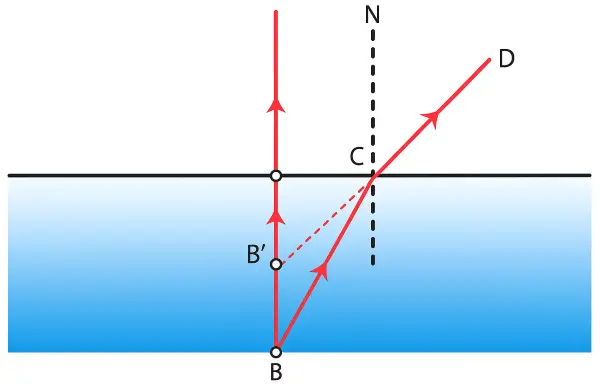
Let an object say B is at the bottom of a pond. Consider a ray of light BC from the object that moves from water to air. The ray moves away from the normal N along the path CD, after refraction from the water surface. The produce of CD appears from the point B’. The virtual image of the object B appears at B’.
Refractive index of water \(=\frac{Real\ Depth\ }{Apparent\ Depth}\)
Question 4
Draw a ray diagram to show the appearance of a stick partially immersed in water. Explain your answer.
Answer:
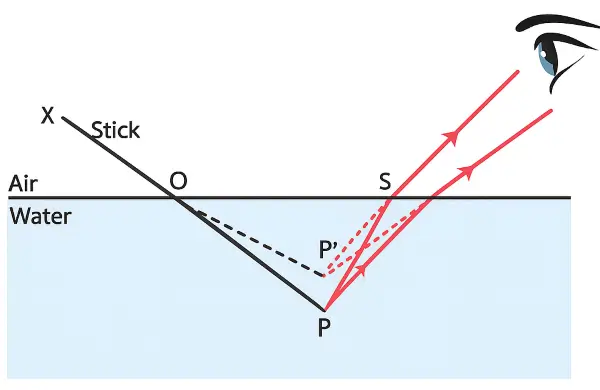
The above figure shows that a stick appears bent or raised which is partially immersed in water in a glass container. This is due to the rays appears to come from P’ which is the virtual image of the tip P of the stick. This is due to the refraction of light from denser medium to rarer medium at the surface separating two media.
Question 5
A fish is looking at a 1.0 m high plant at the edge of a pond. Will the plant appear to the fish shorter or taller than its actual height? Draw a ray diagram to support your answer.
Answer:
The plant appears to be taller than its actual height.
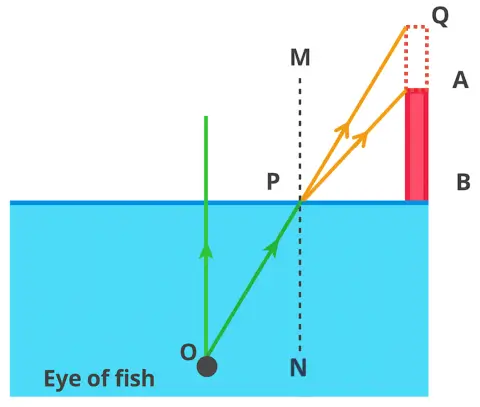
Let the fish is looking from the point O. Since air is a rarer medium in comparison of water, the ray will bend away from the normal MN when the ray OP emerges out from the water to air. But when we extend the ray OP it will meet at Q. Hence due to this, the plant AB will look taller than its actual height.
Question 6
A student puts his pencil into an empty trough and observes the pencil from the position as indicated in the figure.
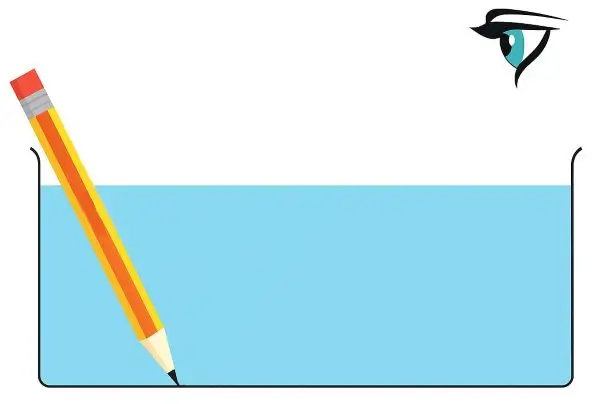
(i) What change will be observed in the appearance of the pencil when water is poured into the trough?
(ii) Name the phenomenon which accounts for the above-started observation.
(iii) Complete the diagram showing how the student’s eye sees the pencil through water.
Answer:
(i) When water is poured into the trough, part of the pencil which is immersed in water will look short and raised up.
(ii) Refraction of light is responsible for the above observation.
(iii) The required diagram is shown below:
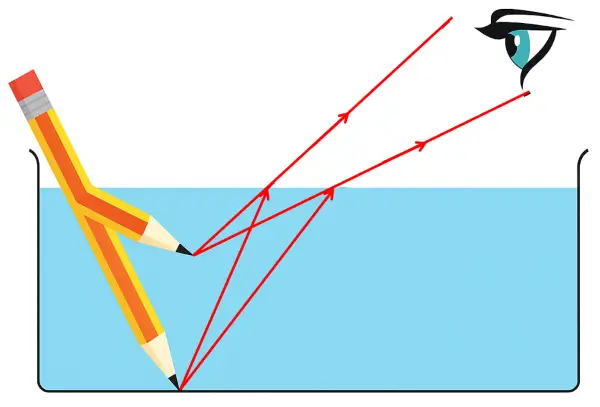
Exercise 4(C): (D) Numericals
Question 1
A water pond appears to be 3 m deep. If the refractive index of water is 4/3, find the actual depth of the pond.
Answer:
Given,
Apparent depth \(=\ 3\ m\)
Refractive index of water, μw \(=\frac{4}{3}\)
We know that,
Real depth = Apparent depth x μw
Real depth \(=3\times\frac{4}{3}\)
Real depth \(=\ 4\ m\)
Hence, Actual depth of the pond \(=\ 4\ m\)
Question 2
A coin is placed at the bottom of a beaker containing water (refractive index = 4/3) at a depth of 16 cm. By what height the coin appears to be raised when seen from vertically above?
Answer:
Given,
Refractive index of the water, \(\mu_w=\frac{4}{3}\)
Real depth at which coin is placed = 16 cm
Shift in the image = ?
We know that,
\(\mu_w=\frac{Real\ Depth\ }{Apparent\ Depth}\)
\(\Rightarrow\ \frac{4}{3}=\frac{Real\ Depth\ }{Apparent\ Depth}\)
\(\Rightarrow\ Apparent\ depth=\ 16\ \times\ \frac{3}{4}\)
\(\Rightarrow\ Apparent\ depth=\ 12\ cm\)
\(.:Shift\ =\ Real\ depth\ -\ Apparent\ depth\)
\(Shift=16-12\)
\(Shift=4\ cm\)
Hence, Coin appears raised by 4 cm.
Question 3
A postage stamp kept below a rectangular glass slab of refractive index 1.5 when viewed from vertically above it, appears to be raised by 7.0 mm. Calculate the thickness of the glass slab.
Answer:
Given,
Refractive index of the glass block, μg = 1.5
Shift in the image = 7 mm or 0.7 cm
Thickness of glass block or real depth = ?
\(Shift\ =\ Real\ depth\ \times\left(1-\frac{1}{\mu}\right)\)
\(\Rightarrow0.7\ =\ Real\ depth\ \times\left(1-\frac{1}{1.5}\right)\)
\(\Rightarrow0.7\ =\ Real\ depth\ \times\frac{0.5}{1.5}\)
\(\Rightarrow Real\ depth=\ \frac{0.7\ \times\ 1.5}{0.5}\)
\(\Rightarrow Real\ depth=\ 2.1\ cm\)
Hence, the thickness of glass slab \(=\ 2.1\ cm\)
Download Free Selina Concise Physics Class 10 Refraction of Light at Plane Surfaces Solutions
You can download free PDF solutions for Selina Class 10 Physics Exercise 4(C) to revise offline. These solutions are exam-ready and designed by subject experts.
Tips for Scoring Better in Exercise 4(C)
- Start with theory questions to secure easy marks.
- For numericals, list the given values clearly before solving.
- Draw neat and labeled ray diagrams wherever needed.
- Double-check unit conversions in your calculations.

